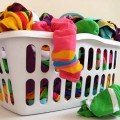Let’s start with a few guidelines for laundry work.
1. Sort the clothes, and wash whites together. By following this simple rule you can avoid the dingy look white clothes can get when they pick up the dye — even in microscopic amounts — from darker clothing.
2. Presoak or pretreat clothing and other items that are heavily soiled.
3. Empty pockets before anything goes into the wash. Facial tissues and other bits and pieces hiding in pockets will cause havoc with your washing, and darker washing in particular.
4. For their well-being, close zippers. However, you’ll need to undo buttons for more effective cleaning.
5. Floating strings (as on aprons) or ties (as in men’s pajama bottoms) should be tied in a bow to prevent tangling.
6. Clothing of any fabric that tends to pill, such as jersey knit, should be turned inside out.
7. Any item in a colour that might bleed should be washed either separately, or with similarly colored items.
8. Use white vinegar in the final rinse to remove all signs of soap. Add borax to the final rinse as a fabric softener.
Water temperature can be a dilemma when it comes to doing the laundry. Using cold water may save on energy, but will it do a good job in every case? The answer is that different fabrics will get cleanest in different water temperatures. Let this chart guide you.
|
Temperature |
Best for |
|
Use cold water |
• Brightly colored items, to stop dyes from bleeding • Any item that might shrink in warmer temperatures, such as some cottons • All rinsing |
|
Use warm water |
• Permanent-press clothes • Wool that is washable • Clothing in synthetic fabrics • Dark-colored items • Most cottons (for 100 percent cottons, use lukewarm water so they won’t shrink) |
|
Use hot water |
• Items that are very soiled • Whites, to help keep them white • Towels • Sheets |
The Clean Cane Formula — for cane, bamboo, rattan and wicker
Clean pieces made from these materials regularly, using a small, stiff brush. To deal with grimy corners and other dirty areas, use a toothbrush dipped in soapy water. Then wipe down with toweling.
Sometimes this type of furniture will yellow as it ages. To help counter yellowing, wipe down with salty water every few months.
Use the Clean Cane Formula on your cane, bamboo, rattan or wicker pieces. The lavender will give a sweet, old-fashioned scent. Substitute another oil if you prefer.
• Va cup liquid castile soap
• 1 cup water
• 6 drops lavender essential oil
Combine these ingredients in a spray bottle. Spray onto the piece, leave for a few seconds, and then wipe down with a damp, clean cloth.









December 29, 2010 at 10:39 pm
Great blog! A pleasure to read.
December 31, 2010 at 12:28 pm
Good blog! I like it.
January 1, 2011 at 12:45 am
Great blog! A pleasure to read.
January 4, 2011 at 5:40 pm
I have study a few of the blog posts on your blog these few days, and I really like your way of blogging. I tag it to my favorites web site list and will be checking back soon. Pls visit my site as well and let me know what you think.
January 7, 2011 at 1:29 am
Good post, but much too much.